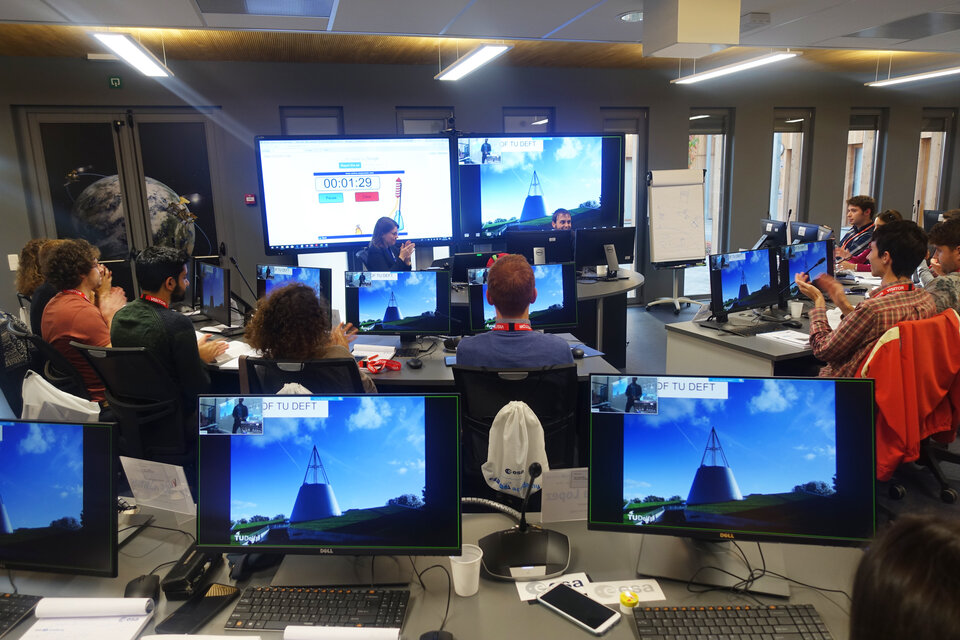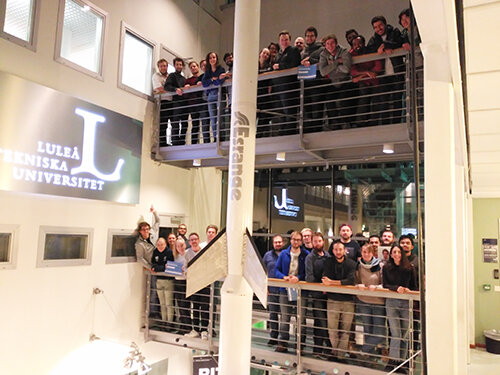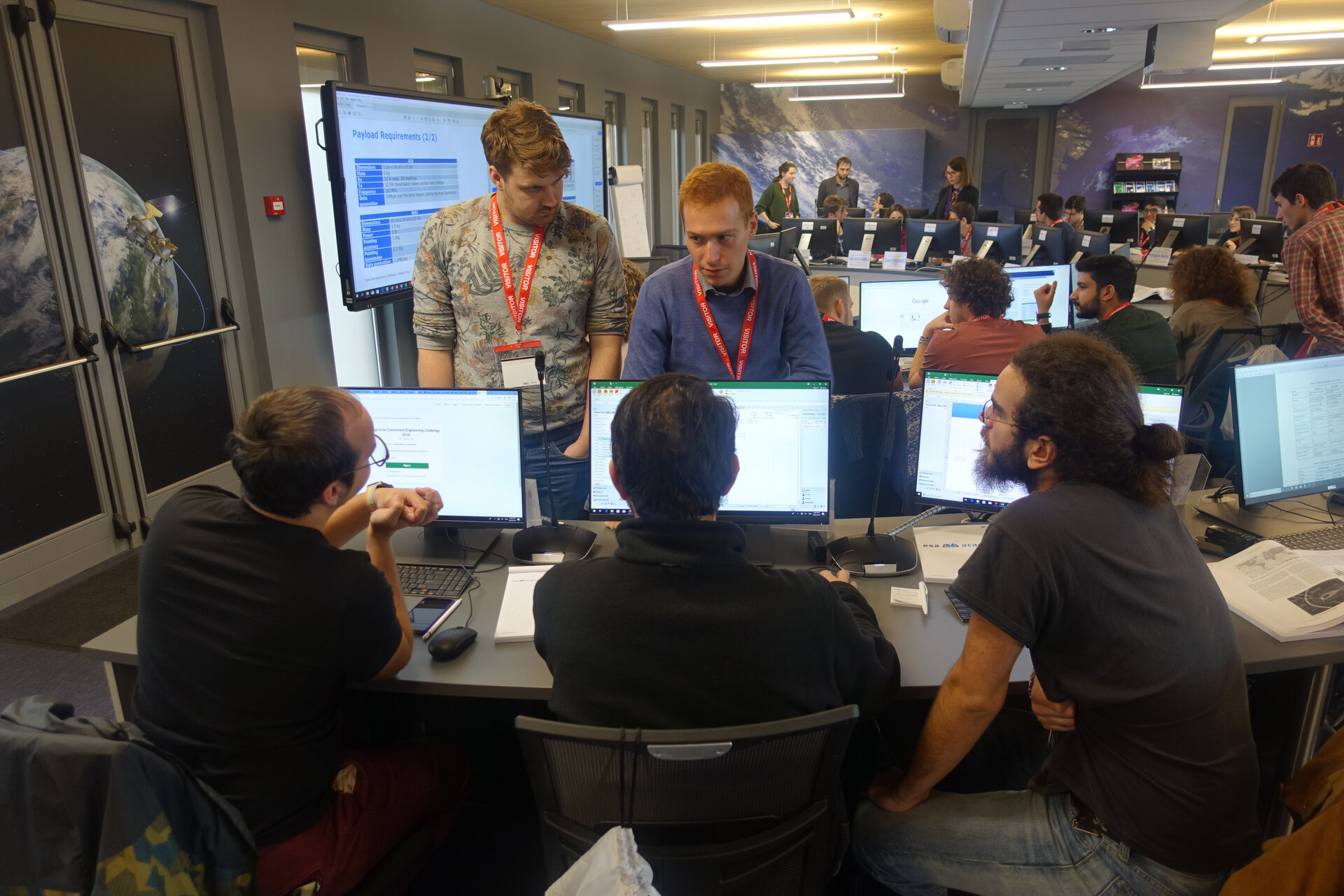Universities are called to apply for the 2019 Concurrent Engineering Challenge
ESA is looking for three universities from ESA Member or Associate States which would like to participate with their students in the third ESA Academy’s Concurrent Engineering Challenge.
This Challenge will be organised during the last quarter of 2019 by the ESA Education Office in collaboration with ESA’s Systems and Concurrent Engineering Section.
"Concurrent Engineering (CE) is a systematic approach to integrated product development that emphasises the response to customer expectations. It embodies team values of co-operation, trust and sharing in such a manner that decision making is by consensus, involving all perspectives in parallel, from the beginning of the product life-cycle.". With respect to traditional design methods, the Concurrent Engineering approach uses a dedicated process and facility, a multidisciplinary team, and an integrated design model so that all subsystems are able to perform the design in the same room, at the same time. This is a far more efficient way of designing, but comes with its own difficulties. A consistent set of design parameters are defined and exchanged throughout the process and any changes that could impact the design on another discipline are identified, communicated and assessed with the entire team. Although Concurrent Engineering is a more complicated process to begin with, in effect it allows for design challenges to be identified earlier, therefore reducing the overall design time.
ESA’s main Concurrent Design Facility (CDF) is located at ESA’s Technology Centre (ESTEC) in the Netherlands.

At ESA Academy's Training and Learning Facility located at the ESA Education Training Centre (ESEC-Galaxia) in Belgium, ESA has developed a similar facility exclusively for educational purposes.
Details of the Challenge
The ESA Academy Concurrent Engineering Challenge 2019 will feature 4 groups of 20-30 University students at Master or PhD level. A first group will be selected, at a later stage, by ESA to participate from the ESA Academy’s Training and Learning Facility. The three others groups will be identified by the universities after summer and will participate from their respective Concurrent Engineering Facilities (CEFs).

Each group will be supervised by two system engineers and will be given, at the start of the Challenge, the same space mission to design within five days. Students in each group will be divided into small teams of two or three to cover the following disciplines:
- structures,
- configuration,
- power,
- mechanisms,
- thermal,
- attitude and orbit control,
- propulsion,
- trajectory analysis,
- communications and data handling.
Students within each small team will design their subsystem using the Concurrent Engineering approach with the objective of complying with the mission requirements and prove feasibility.
The groups will not compete against each other, but will rather use video conferencing and live messaging forums to share each day’s progress, raise any particular challenges they are facing, and receive feedback from the other participants. At the end of the week, each group will present their final design to the others.
Preliminary schedule of the Challenge:
| Day 1 |
Introduction to the Concurrent Engineering Approach Get familiar with Workbooks and OCDT Presentation of each CEF Introduction to the mission Mission overview and requirements |
| Day 2 |
System requirements Mission and system modes definition First iteration of all subsystems Each group results presentation |
| Day 3 |
First iteration of all subsystems First budgets Finalisation of the concept Each group first results presentation |
| Day 4 |
Second iteration of all subsystems Product tree Budgets Each group second iteration presentation |
| Day 5 |
Final design consolidation & any open issues Each group final presentation |
Universities involved in the Challenge will benefit from receiving feedback on their design from ESA experts, learn about the Concurrent Engineering approach and its benefits, the Open Concurrent Design Tool (OCDT) and how to organise a Concurrent Engineering study with University students.
Certificates of participation will be send to each university to be distributed to the participants. The certificates will have the logo and signature of each participating university and ESA.
Application
Applications are now open for Universities. In order to participate, universities should fill in the application form and must fulfil the following criteria:
- Be located in an ESA Member or Associate States;
- Have a CEF facility or commit to develop one for the Challenge;
- Have or commit to have a network of more than 15 dedicated computers in this facility;
- Have or commit to have capabilities for videoconferencing (large screens, microphone(s), cameras, loud speakers,…) in this facility;
- Use OCDT or commit to install the tool and learn how to use it before the Challenge;
- Have a professor appointed to coordinate the preparation and organisation of the Challenge at the University;
- Have two professors with some design knowledge and familiarity in space systems, willing to learn the Concurrent Engineering approach and OCDT, appointed as system engineers for the Challenge;
- Have a technician to support the use of OCDT, Concord add-in and video conferencing system during the Challenge;
- Identify a potential group of 20-30 participating Msc or PhD students in the University;
- Have support material to assist students during design sessions such as books and specific domain software (for example CAD or trajectory analysis software);
- Commit to collaborate with ESA and the other participating universities during the preparation and organisation of the Challenge, to attend the meetings and to meet the milestones:
-
- 2-3 months before the Challenge: the CEF should be ready and operational
- 1-2 months before the Challenge: the OCDT and related workbooks should be installed and the two system engineers should be familiar with the material and the Concurrent Engineering approach
- 1 months before the Challenge: students should be identified and information about participants should be provided to ESA
The deadline for applications is 28 March 2019, 23:59 CET.
For more information, please contact tlp @ esa.int and have a look at how the results of the 2018 Challenge.















 Germany
Germany
 Austria
Austria
 Belgium
Belgium
 Denmark
Denmark
 Spain
Spain
 Estonia
Estonia
 Finland
Finland
 France
France
 Greece
Greece
 Hungary
Hungary
 Ireland
Ireland
 Italy
Italy
 Luxembourg
Luxembourg
 Norway
Norway
 The Netherlands
The Netherlands
 Poland
Poland
 Portugal
Portugal
 Czechia
Czechia
 Romania
Romania
 United Kingdom
United Kingdom
 Slovenia
Slovenia
 Sweden
Sweden
 Switzerland
Switzerland


























